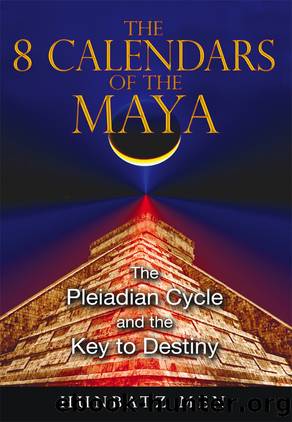The 8 Calendars of the Maya by Hunbatz Men

Author:Hunbatz Men
Language: eng
Format: epub
Tags: Mayan Studies/New Age
ISBN: 9781591439875
Publisher: Inner Traditions/Bear & Company
Published: 2010-02-25T00:00:00+00:00
Indicates the position of the Moon at its greatest northern declination, coinciding with March 21.
Western sunset point, coinciding with March 21 each year: the spring equinox.
Indicates the position of the Moon at its maximum southern declination, coinciding with December 21.
Geographic south.
The Great Idol of Tiwanakâu, Bolivia
Forms of Mesoamerican calendars can be found throughout the Americas. One example is the so-called Great Idol of Tiwanakâu. In reality a monolith representing a priest of Pachamama (literally, âEarth Motherâ), it has been referred to by Eurocentric archaeologists as the Bennett Monolith, after Wendell Bennett, the archaeologist who unearthed it in 1932, where it had been buried in the complex of ruins on the Bolivian altiplano called Tiwanakâu. This monolith measures 7.30 meters in length by 1.30 meters in width and is intricately carved with the same iconography found at the Gateway of the Sun, at the same site, including the same calendar inscriptions. It is necessary to study this statue carefully, as did the Austrian naval engineer, geomorphologist, and naturalized Bolivian Arthur Posnansky, who visited the ancient site while it was being excavated and became so mesmerized that he later dubbed himself the Apostle of Tiwanakâu. He later wrote about how he dragged himself in the mud to lie underneath the monolith, then being excavated, and, candle in hand, removed the mud off the back of the statue with his fingernails, marveling at the intricate carvings thus exposed. Posnansky was responsible for removing the statue from Tiwankâu to the Bolivian capital of La Paz. It was returned to the native Aymara people at Tiwanakâu in 2002.
Posnansky wrote, âThe idol of Tiwanakâu holds what appears to be a vessel (keru) in its left hand, which may be a clepsidra (hourglass). In his belt appear a series of lobsters, which are possibly equivalent to crayfish, namely, the zodiacal sign of the Age of Cancerâ (see figure 3.7).
Let us analyze Posnanskyâs last comparison. Taking European astrology, with its origins in Greek mythology, into consideration, we might mention that the ancient Greeks drew their astrological and astronomical knowledge, along with a great deal of their culture, from the Egyptians. For example, if we examine the form of the Great Sphinx of Egypt, we will see that its body resembles that of the lion (Leo). For this reason, we can infer that the figure of the crayfish in the belt of the monolith of Tiwanakâu represents the sign of Cancer.
Download
This site does not store any files on its server. We only index and link to content provided by other sites. Please contact the content providers to delete copyright contents if any and email us, we'll remove relevant links or contents immediately.
The Complete Stick Figure Physics Tutorials by Allen Sarah(7338)
Secrets of Antigravity Propulsion: Tesla, UFOs, and Classified Aerospace Technology by Ph.D. Paul A. Laviolette(5333)
Thing Explainer by Randall Munroe(3910)
The River of Consciousness by Oliver Sacks(3572)
The Order of Time by Carlo Rovelli(3162)
How To by Randall Munroe(3074)
A Brief History of Time by Stephen Hawking(2992)
I Live in the Future & Here's How It Works by Nick Bilton(2960)
What If?: Serious Scientific Answers to Absurd Hypothetical Questions by Randall Munroe(2670)
The Great Unknown by Marcus du Sautoy(2662)
Midnight in Chernobyl by Adam Higginbotham(2516)
Blockchain: Ultimate Step By Step Guide To Understanding Blockchain Technology, Bitcoin Creation, and the future of Money (Novice to Expert) by Keizer Söze(2467)
Networks: An Introduction by Newman Mark(2382)
The Meaning of it All by Richard Feynman(2319)
Easy Electronics by Charles Platt(2308)
The Tao of Physics by Fritjof Capra(2247)
Midnight in Chernobyl: The Untold Story of the World's Greatest Nuclear Disaster by Adam Higginbotham(2196)
When by Daniel H Pink(2098)
Introducing Relativity by Bruce Bassett(2097)
